Whether it is modern industrial manufacturing or artistic processing, there is a seemingly simple but critical process that can make rusty steel look brand new, make smooth glass look hazy and beautiful, and even make the surface of rocket engine parts more resistant to high temperatures – bead blast. This technology uses tiny particles produced by high-speed impact to give the surface of the material a new “life” and is known as the “magical polishing technology” in the industrial field.
What is a bead blast?
Bead blast is a precise surface treatment process achieved through physical impact. It uses compressed air or centrifugal force to spray abrasive particles such as steel shots, glass beads, and ceramic sand at high speed onto the surface of objects, thereby completing operations such as cleaning, roughening, or fine processing. In the field of industrial manufacturing, bead blast technology holds an indispensable position: it can thoroughly remove rust, coating residues, and microscopic burrs from metal surfaces, and by precisely controlling the surface roughness, it significantly enhances the adhesion effect of spraying and electroplating.
The application scope of this technology is extremely wide, ranging from the manufacturing of automotive parts, the processing of precision components in aerospace, to the surface treatment of electronic components and the beautification of building decoration materials. Its unique advantage lies in the combination of efficiency and flexibility. Whether it is dealing with micron-level precision parts or large steel structural components, the bead blast process can replace traditional chemical corrosion methods with “physical impact” and has become one of the core technologies for surface cleaning and modification in modern industry.
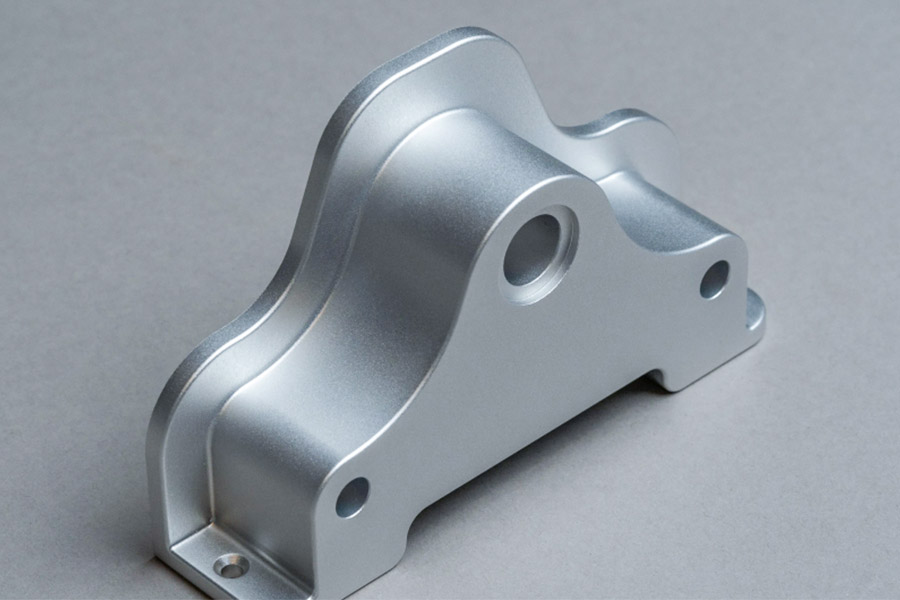
How does bead blast work?
The bead blast process treats the surface of an object by spraying abrasive particles at high speed. The entire process is closely linked, and the specific steps are as follows:
- Surface pretreatment: Before bead blast, the surface of the workpiece must be thoroughly cleaned to completely remove adhering debris, oil stains, rust and other impurities. A clean surface can make bead blast treatment more efficient and ensure that the final effect meets expectations.
- Abrasive selection: Based on the material of the workpiece and processing requirements, precisely select the appropriate type and particle size of abrasive. For example, steel shot with higher hardness can be selected to remove metal rust. For a matte texture or a smooth and rough surface, abrasives such as glass beads and ceramic sand are more suitable.
- Equipment preparation: Bead blast operations rely on professional equipment – bead blast machines (also known as pearlescent machines). This equipment is mainly composed of a bead blast cabinet/bead blast chamber, nozzles/spray guns, and a compressed air system or centrifugal device that provides power. A closed bead blast space can ensure operational safety and reduce the spread of dust.
- Bead blast operation: The selected abrasive is loaded into the bead blast chamber. After starting the equipment, the abrasive is driven by compressed air or centrifugal force and sprayed at high speed onto the surface of the workpiece through the nozzle. The powerful impact force enables the abrasive to fully contact the surface, initiating the processing procedure.
- Surface treatment: When high-speed flying abrasives strike the surface of the workpiece, they simultaneously produce the dual effects of impact and grinding. The impact force can peel off attachments such as rust layers and dirt. Grinding force can refine the surface texture, make rough surfaces smooth, or create a unique matte effect.
- Abrasive recovery: To prevent abrasive from scattering and polluting the environment, the bead blast chamber adopts a fully enclosed design and is equipped with a vacuum or mechanical recovery system. Used abrasives and debris will be collected in a timely manner. After screening, dust removal and other treatments, some abrasives can be reused, reducing production costs.
- Quality inspection and post-treatment: After bead blast is completed, the surface treatment effect should be carefully inspected to confirm whether the roughness, cleanliness and other indicators meet the standards. According to actual needs, secondary processing such as cleaning, spraying and coating may be required in the future to further improve the performance and appearance of the workpiece.
Bead blast technology, with its efficient and flexible characteristics, plays a significant role in areas such as surface cleaning, pretreatment, and finishing, and is an indispensable key technology in modern industrial production.
What are the advantages and disadvantages of bead blast?
Bead blast treatment, with its remarkable treatment effect, holds an important position in the surface processing of numerous materials and parts. Its advantages and limitations coexist:
Core advantage
- High-efficiency cleaning: Bead blast can quickly remove rust, oxide scale from the metal surface, as well as oil stains, coating residues and other impurities on the surface of various materials, restoring the surface to a clean and smooth state and laying a high-quality foundation for subsequent processing.
- Wide application: Whether it is metal alloys, engineering plastics, glass or composite materials, the bead blast process can be adapted to all of them. From deburring mechanical parts, surface finishing of electronic products to texture treatment of building decoration materials, the application scenarios are extremely diverse.
- Uniform effect: With the precise control of professional equipment, even when dealing with complex-shaped workpieces or large flat areas, bead blast can achieve a uniform surface treatment effect, ensuring the overall quality is stable.
- Texture customization: By adjusting the type, particle size and spraying parameters of the abrasive, a variety of surface textures ranging from rough and anti-slip to fine matte and satin gloss can be shaped as needed. This not only meets functional requirements (such as enhancing grip strength), but also optimizes the visual texture.
- Performance enhancement: Bead blast treatment can effectively release the surface stress of materials, improve the internal structure, significantly enhance the fatigue resistance and wear resistance of parts, and extend their service life.
Core disadvantage
- Material loss: The impact of high-speed abrasives can cause slight peeling on the material surface. In fields with strict requirements for dimensional tolerances, such as precision parts manufacturing and high-precision mold processing, this may affect the accuracy of the finished product. Therefore, it is necessary to strictly control the process parameters.
- Surface damage risk: For soft metals such as aluminum and magnesium, as well as thin-walled plastic parts, overly strong bead blast impact force can easily cause surface scratches, pits, and even lead to part deformation. Therefore, the hardness of the abrasive and the bead blast pressure should be carefully selected.
- The operation and maintenance costs are relatively high: During the bead blast process, a large amount of dust and debris are produced, which not only threaten the health of the operators but also require the installation of professional dust removal equipment, closed bead blast rooms and personal protective gear. Meanwhile, the daily maintenance of the equipment and the recycling and treatment of abrasives have also increased the overall processing cost.
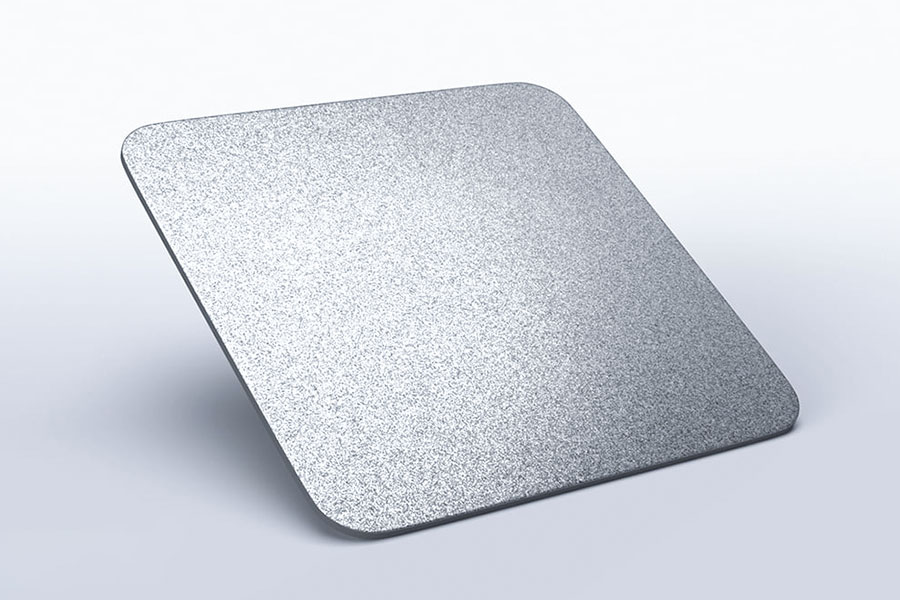
Bead Blasting vs Sandblasting: Which Delivers Higher Precision?
According to ISO 8501-1 standard and process parameter analysis, bead blast has significantly higher precision than sandblasting, especially in terms of surface roughness control and substrate protection. The following are key comparisons and technical decision-making basis:
1. Comparison of core precision indicators
| Parameters | Bead Blasting | Sandblasting |
|---|---|---|
| Media type | Glass beads (spherical, ISO 11124-3) | Alumina sand (angular, ISO 11126-8) |
| Surface roughness Ra | 0.4-3.2μm (mirror to semi-gloss) | 3.2-12.5μm (matt to coarse sand) |
| Substrate deformation | <0.01mm (controllable at the micron level) | ≤0.05mm (easy to affect thin-walled parts) |
| Impact energy distribution | Spherical media have uniform impact and small stress concentration | Angular media have strong cutting effect and large stress fluctuations |
2.Analysis of precision advantage scenarios
High-precision manufacturing (Ra≤1.6μm)
Bead blast can achieve nano-level surface control under 0.3-0.6MPa pressure through glass microbeads (0.05-0.3mm), for example:
Semiconductor packaging mold: Ra 0.8μm, to ensure photoresist adhesion;
Artificial joint titanium alloy: Ra 1.2μm, to promote bone cell adhesion.
Micro-deformation sensitive parts
The spherical impact of bead blast can reduce the risk of plastic deformation by more than 60%, suitable for:
- Aviation aluminum alloy skin (thickness <1mm);
- MEMS sensor silicon wafer (brittle material protection).
- Functional surface strengthening
Bead blast simultaneously achieves surface cleaning + compressive stress strengthening, for example:
- Gear tooth surface: Ra 0.4μm + residual compressive stress 500MPa, fatigue life increased by 200%;
- 3D printed metal parts: eliminate interlayer step effect (Ra reduced from 12μm to 3.2μm).
3.Application fields of sandblasting
Sandblasting has more advantages in efficiency and economy, and is suitable for:
- Quick rough processing: rust removal of steel structures (Sa2.5 cleanliness, Ra 6.3-12.5μm);
- Macro texture shaping: roughening of concrete walls (Ra≥25μm);
- Removal of heavily polluted layers: stripping of residual sand from castings (the impact force of alumina sand is 3-5 times higher than that of bead blast).
Bead blast leads in terms of precision and is particularly suitable for micron-level surface control, thin-walled parts processing and functional enhancement scenarios; while sandblasting is more suitable for rapid rough processing and cost-sensitive projects. When selecting a model, it is necessary to conduct a systematic evaluation based on the Ra value requirements, substrate thickness, cost budget and subsequent processes (such as electroplating/spraying).
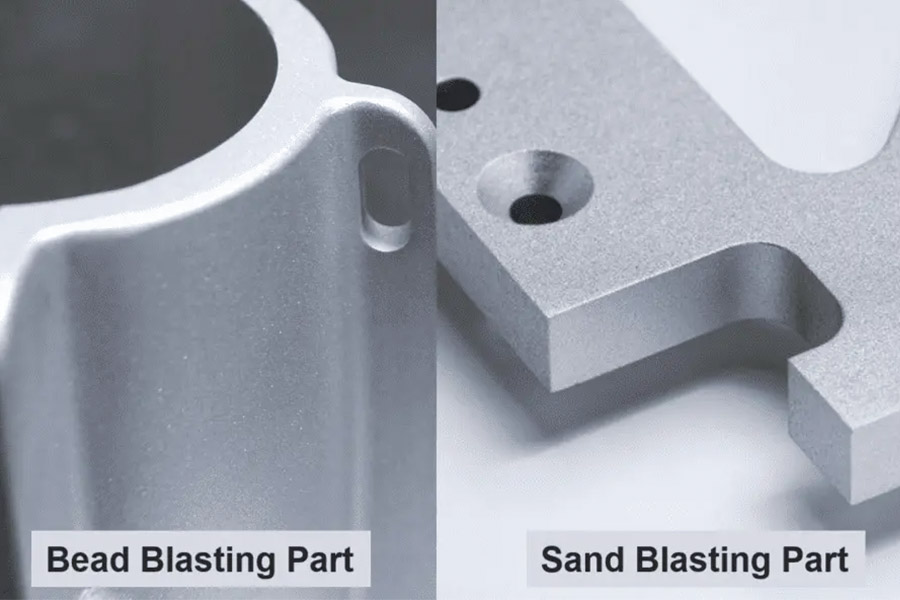
What materials are used for bead blast ?
The materials used for bead blast mainly include the following types, and different materials have different characteristics and applicable scenarios:
1. Abrasive types and characteristics
| Abrasive type | Material | Particle size range (μm) | Typical applications | Advantages and disadvantages |
|---|---|---|---|---|
| Glass beads | Silicate glass | 50–300 | Polishing of stainless steel and aluminum alloy surfaces | Low hardness, no damage to the substrate, but limited improvement in roughness |
| Alumina (brown corundum) | Alumina (Al₂O₃) | 16–800 | Rust removal of castings, strengthening of heat-treated parts | High hardness, low cost, but easy to break and produce dust |
| Silicon carbide | Silicon carbide (SiC) | 24–600 | Surface treatment of ceramics and cemented carbide | Extremely high hardness, suitable for high-strength processing, but expensive |
| Steel shot/steel grit | Carbon steel or stainless steel | 0.2–2.0 mm | Ship steel plate, heavy machinery surface strengthening | Recyclable, but easy to rust, need to be replaced regularly |
| Walnut shell | Natural plant fiber | 0.5–3.0 mm | Cleaning of wood and plastic surfaces | Environmentally friendly and pollution-free, but low strength, only suitable for gentle processing |
What are the applications of bead blast?
As an efficient surface finishing technology, bead blast process plays a significant role in industrial production due to its unique processing characteristics. This process forms a uniform and non-directional texture by high-speed ejection of abrasives, which not only achieves a fine matte texture but also effectively reduces the surface reflectivity. Therefore, it has been widely applied in multiple key fields.
In the field of aerospace manufacturing, bead blastis used as a standard pretreatment process before painting aircraft components. By removing surface impurities and creating a microscopic rough structure, it significantly enhances the adhesion of coatings and the uniformity of the paint surface, which is particularly important for aviation equipment that needs to withstand extreme environmental tests. In the automotive industry, this process is widely used in the surface treatment of body panels and precision parts. The non-directional texture it forms can effectively eliminate the stripe defects caused by traditional processing, ensure the precise fit between parts, and provide an ideal base for subsequent painting.
In military equipment manufacturing, the special optical properties of bead blast technology are utilized. By creating a diffuse reflection structure on the surface of weapon systems, it significantly reduces the visible light and infrared characteristics of the equipment in battlefield environments, thereby greatly enhancing the battlefield survivability of combat units. In the medical equipment manufacturing field, this process is valued for its ability to optimize the surface of aluminum instruments. The uniform and fine surface it forms not only meets the strict hygiene standards of medical devices but also complies with the dimensional stability requirements of precision instruments.
In the consumer-oriented industries such as food and pharmaceuticals, the application of bead blast technology demonstrates dual values. It can serve as a functional treatment method to ensure the cleanliness of the surface of production equipment and prevent the growth of microorganisms; it can also enhance the appearance texture of products through a matte decorative effect. This technological advantage is particularly evident in the manufacturing of pharmaceutical machinery, food processing equipment, and high-end consumer goods.
From the perspective of engineering practice, bead blast has broken through the limitations of traditional surface treatment and developed into a composite processing technology that integrates functional strengthening and aesthetic improvement. Its non-directional texture feature and controllable roughness parameters not only meet the strict requirements of industrial products for surface performance but also enable fine control of visual effects. This dual advantage makes it irreplaceable in modern manufacturing.
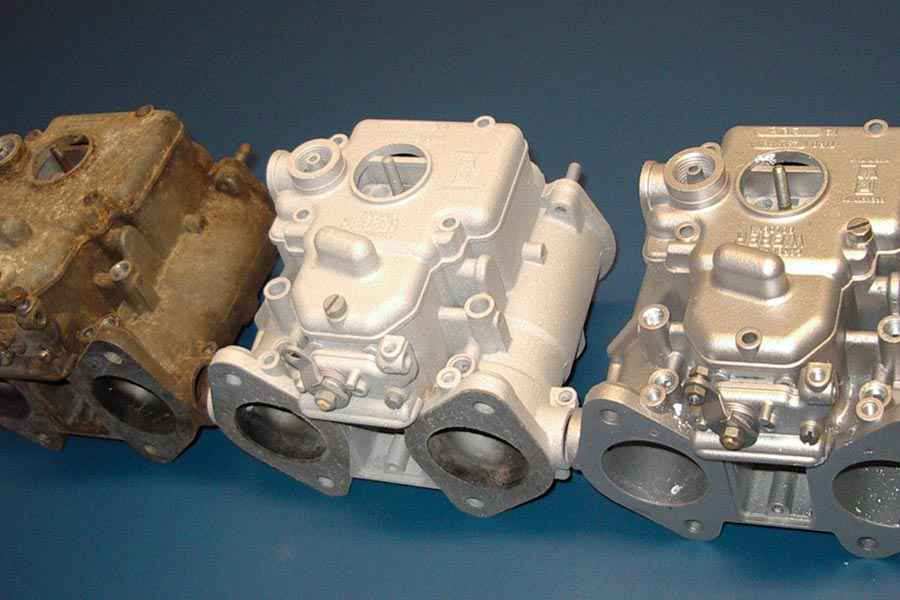
What equipment is used for bead blast?
There are various types of equipment used for bead blast. Here are some of the main types and their characteristics:
Dry bead blast machine:
- Features: Simple operation, economical, and fast working efficiency. However, it generates a certain amount of dust during operation, so a dust removal system or atomization equipment is required.
- Application scope: Suitable for surface treatment of various metal and non-metal materials, such as rust removal, cleaning, and increasing surface roughness.
- Classification: Dry bead blast machines can be divided into suction type bead blast machines and pressure type bead blast machines. Suction type bead blast machines use the negative pressure formed by the high-speed movement of air in the gun to suck in the abrasive for spraying; pressure type bead blast machines use the working pressure established in the pressure tank by compressed air to press the abrasive into the sand delivery pipe and spray it through the nozzle.
Liquid bead blast machine (wet bead blast machine):
- Features: By mixing the abrasive with water for spraying, it effectively controls the dust pollution during the bead blast process and improves the working environment.
- Application scope: Suitable for occasions with high dust control requirements, such as surface treatment of food processing equipment and electronic components.
Box-type bead blast machine:
- Features: It adopts a box-type closed structure and automatically recovers, dusts, and separates the abrasive during operation. The efficiency is lower than that of open type, but it has certain requirements for the size of the workpiece.
- Application scope: Suitable for batch processing of small workpieces, and automatic bead blast machines in the form of turntables, trolley conveyors, and mesh belt conveyors can also be customized according to the size of the workpiece.
Automatic bead blast machine:
- Features: Achieves automated operation, including automatic bead blast, automatic workpiece entry and exit, automatic gun swinging, automatic abrasive sorting, and automatic dust removal.
- Application scope: Suitable for customers with large workloads, such as pretreatment before painting and powder coating of construction machinery, mining machinery, agricultural machinery, and refurbishment of old equipment.
- Classification: Includes conveyor type automatic bead blast machines, turntable type automatic bead blast machines, belt type automatic bead blast machines, and non-standard automatic bead blast machines. These devices can be customized according to the specific needs of users.
Manual bead blast machine:
- Features: Compact structure, easy to move, suitable for surface treatment of small workpieces.
- Application scope: Such as rust removal, cleaning, and bead blast treatment of small workpiece surfaces. Simple operation, easy maintenance, and no special skills required.
LS’s High-Quality Finishing Services
Bead blasting finish is one of the best finishing choices for your applications. However, having your project in the wrong hands may prove harmful. So, you should be able to search for experience and expertise. The best company that offers a perfect mix of both is LS.
LS has years of experience offering cost-effective surface finish solutions for various industries. We offer an extensive array of materials and finishes, including metal plating. Our team of experts works with you to create a custom metal finishing procedure. This way, you can be sure of high-quality services that meet your unique needs.
We prioritize customer satisfaction at LS. All our services come at competitive rates. All you have to do is contact us or upload your design file today. You will receive an instant quote, and we are ready to work.
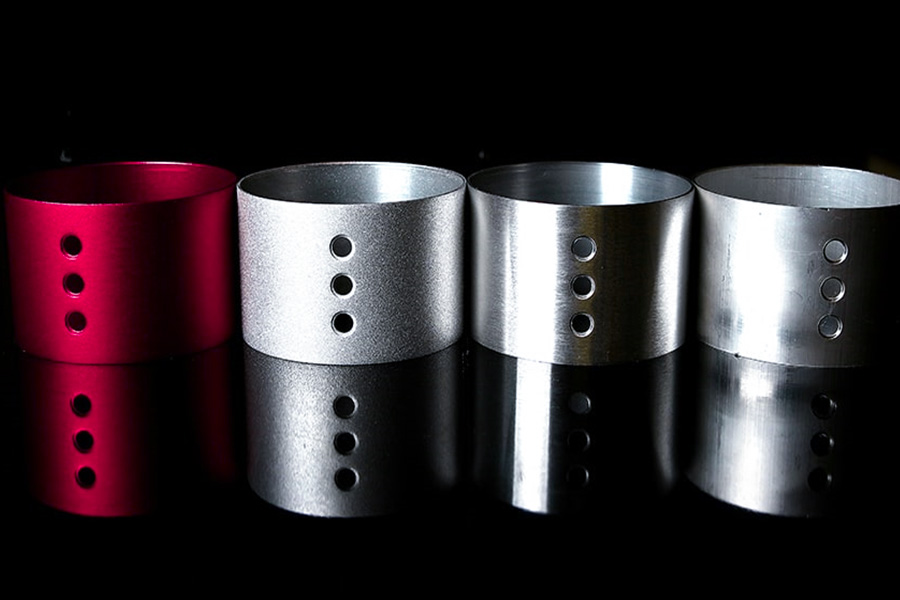
Summary
A bead blast finish is ideal for getting semi-polish, satin-like finishes on your parts. It is a versatile surface finishing technique that works well on various materials and is suitable for an extensive list of applications. It is also less aggressive and relatively affordable, making it a great choice for your project.
However, it would be best to work with a reliable partner to get the best results from a bead blast surface finish. LS offers high-quality parts finishing services at very competitive prices. We are committed to meeting the needs of parts requiring a variety of surface finishes. Contact us to get expert advice for your next project. If you’re ready to work with us, request a quote today!
📞 Phone: +86 185 6675 9667
📧 Email: info@longshengmfg.com
🌐 Website: https://lsrpf.com/
Disclaimer
The content of this page is for informational purposes only.LS SeriesNo representations or warranties of any kind, express or implied, are made as to the accuracy,completeness or validity of the information. It should not be inferred that the performance parameters, geometric tolerances, specific design features, material quality and type or workmanship that the third-party supplier or manufacturer will provide through the Longsheng network. This is the responsibility of the buyerAsk for a quote for partsto determine the specific requirements for these parts.please Contact us Learn more information.
LS Team
LS is an industry-leading companyFocus on custom manufacturing solutions. With over 20 years of experience serving more than 5,000 customers, we focus on high precisionCNC machining,Sheet metal fabrication,3D printing,Injection molding,metal stamping,and other one-stop manufacturing services.
Our factory is equipped with more than 100 state-of-the-art 5-axis machining centers and is ISO 9001:2015 certified. We provide fast,efficient and high-quality manufacturing solutions to customers in more than 150 countries around the world. Whether it’s low-volume production or mass customization,we can meet your needs with the fastest delivery within 24 hours. chooseLS TechnologyIt means choosing efficiency, quality and professionalism.
To learn more, please visit our website:www.lsrpf.com

FAQs
1.What is the purpose of bead blast?
The purpose of bead blast is to remove contaminants from the surface of materials (such as rust, scale, casting sand, etc.), to achieve a certain degree of cleanliness and roughness on the surface of the workpiece, to improve mechanical properties (such as fatigue resistance), to enhance the adhesion of coatings, to extend the durability of the coating film, and it can also be used for decorative treatments (such as anti-slip treatment on plastic surfaces or pattern making on glass).
2.How much does bead blast cost?
The cost of bead blast varies depending on the type of workpiece, the cleanliness level required, the type of abrasive used, and the difficulty of the operation. Open bead blast is relatively cheaper, while environmentally friendly dust-free bead blast is more expensive. Generally, the price for environmentally friendly dust-free bead blast starts at about 50 yuan. For rust removal on the ground before assembling steel structures, the cost is approximately 800 – 1,500 yuan per ton. For the renovation of steel structures, the cost for rust removal by bead blast is about 1,500 – 2,500 yuan per ton. For bead blast processing of steel structures (using quartz sand), the cost is about 25 – 30 yuan per square meter. For bead blast processing of pipes (using quartz sand), the cost is about 20 – 22 yuan per square meter. For bead blast processing of the inner walls of pipes (using quartz sand), the cost is about 50 – 65 yuan per square meter.
3.Can bead blast be used for precision or complex parts?
Bead blast can be used for precision or complex parts. It uses compressed air or centrifugal force to spray small-diameter shot particles (such as steel shot, glass shot) at high speed onto the surface of parts. It is suitable for parts of any complex shape and can cause plastic deformation, cold work hardening, and residual compressive stress, thereby increasing the service life of the parts.
4.Is glass bead bead blast safe?
Glass bead bead blast is relatively safe. Glass beads are made of high-quality glass, finely ground and strictly screened, with uniform particle size and moderate hardness. They can effectively remove surface impurities without damaging the base material. They have good chemical stability and do not react with acids, alkalis, or other substances. They are also environmentally friendly and pollution-free. However, glass beads are relatively soft and have insufficient wear resistance. During use, they are prone to breakage and produce dust, which may be harmful to workers’ health. Additionally, they have a limited number of recycling cycles.




